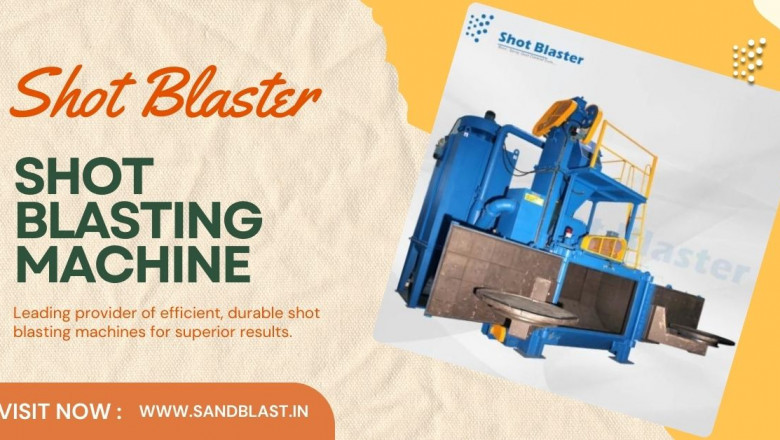views
Portable shot blasting machines are essential tools for surface preparation in industries such as construction, shipbuilding, and automotive manufacturing. Proper operation ensures safety, efficiency, and longevity of the equipment.
This guide provides step-by-step instructions on safely and effectively using a portable shot blasting machine.
Importance of Safety & Efficiency in Shot Blasting
- Safety: Prevents injuries and equipment damage.
- Efficiency: Ensures optimal surface treatment with minimal wastage.
- Longevity: Regular maintenance and correct operation enhance machine durability.
Pre-Operation Preparations
1. Wear Proper Safety Gear
- Use protective clothing, gloves, and steel-toed boots.
- Wear a full-face respirator to prevent inhalation of dust and abrasive particles.
- Use ear protection to mitigate noise exposure.
2. Inspect the Machine and Components
- Check the blast hose and nozzle for wear or blockages.
- Ensure the abrasive material is appropriate for the application.
- Verify that all connections are secure and leak-free.
3. Prepare the Work Area
- Ensure the area is well-ventilated to control dust.
- Remove any flammable materials from the vicinity.
- Set up protective barriers to prevent unauthorized access.
Operating the Portable Shot Blasting Machine

Start the shot blasting machine by connecting it to a reliable power source. Load the correct media into the abrasive hopper and activate the air compressor. Adjust air pressure and abrasive flow for efficiency. Test on a small area before blasting. Hold the nozzle at 45° for even coverage, maintain steady movement, and avoid excessive blasting to prevent surface damage.
1. Start the Machine
- Connect the machine to a reliable power source.
- Open the abrasive hopper and load the correct media.
- Activate the air compressor to achieve optimal pressure levels.
2. Adjust Settings for Optimal Performance
- Set the appropriate air pressure based on the surface type.
- Control the abrasive flow to prevent excessive material usage.
- Test the setup on a small area to ensure uniform coverage.
3. Begin Blasting Process
- Hold the nozzle at a suitable angle (usually 45 degrees) for efficient cleaning.
- Maintain a steady movement to ensure even surface coverage.
- Avoid excessive blasting in one area to prevent surface damage.
Post-Operation Procedures
1. Turn Off the Machine Safely
- Shut down the air compressor and close the abrasive feed valve.
- Release pressure from the system before disconnecting hoses.
- Store unused abrasive materials in a dry, secure place.
2. Clean the Equipment
- Remove residual abrasive from the machine to prevent clogging.
- Inspect all parts for signs of wear and replace if necessary.
- Store the machine in a clean, dry environment.
3. Maintenance & Troubleshooting
- Regularly inspect and replace worn-out blast nozzles.
- Check for air leaks and fix them immediately.
- Lubricate moving parts to prevent rust and ensure smooth operation.
Also Check - https://mackenzie4880.hocoos.com/blog/best-shot-blasting-machines-for-industrial-use-top-picks-amp-buying-guide
Best Practices for Safe & Efficient Shot Blasting
1. Use the Right Abrasive Material
- Different surfaces require different abrasives, such as steel grit, aluminum oxide, or glass beads.
- Selecting the correct media prevents surface damage and enhances the blasting outcome.
2. Control Dust Emissions
- Use dust collection systems to reduce airborne particles.
- Ensure proper ventilation to maintain air quality and visibility.
- Regularly clean filters in dust extractors to maintain efficiency.
3. Maintain a Safe Distance
- Stand at a safe distance from the work surface to prevent ricocheting particles.
- Use long-reach hoses to control movement safely without direct exposure.
- Avoid pointing the nozzle at people or fragile surfaces.
4. Monitor Air Pressure and Flow
- Too much pressure can damage surfaces, while too little pressure reduces efficiency.
- Regularly check and adjust the compressor settings for optimal performance.
- According to Shot Blaster, replace air filters as needed to maintain consistent pressure levels.
Common Mistakes to Avoid
1. Ignoring Safety Protocols
- Not wearing protective gear can lead to severe injuries.
- Overlooking proper ventilation may result in health hazards.
2. Using Incorrect Abrasives
- Using the wrong media can cause damage to the surface or inefficient cleaning.
- Always verify compatibility before starting the blasting process.
3. Neglecting Equipment Maintenance
- Failing to clean the machine regularly leads to clogging and reduced efficiency.
- Lack of lubrication can result in mechanical failures over time.
Conclusion
Operating a portable shot blasting machine requires careful adherence to safety measures and operational best practices. By following the guidelines outlined above, users can enhance productivity while ensuring workplace safety.
Proper maintenance further ensures the longevity of the equipment, making it a valuable asset in industrial applications.














Comments
0 comment